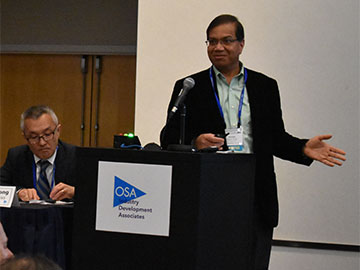![]()
[Image: Maurizio Pesce/Flickr]
On Monday, 14 May, in conjunction with the opening day of the CLEO 2018 conference in San Jose, Calif. (USA), the OSA Industry Development Associates (OIDA) held an Executive Forum centered around the explosive market in sensing, and where optics fits into it all. The forum brought together a few score leaders in various aspects of the optics and photonics supply chain, to talk about what the sensor business—driven by hot areas such as autonomous-vehicle research, AI and the Industrial Internet of Things (IIoT)—needs from the photonics industry, and where the killer apps for photonics lie.
OPN was on hand for the second session of the day, on the role of optics in “the wide world of consumer imaging.” And while that world is indeed a wide one, the focus of the afternoon’s discussion was decidedly on the new experiences and business opportunities offered by virtual reality (VR), augmented reality (AR), and mixtures of the two.
From science fiction to deployed products
In introducing the session, the moderator, Alex Fong of the hyperspectral-imaging company TruTag Technologies, gave a nod to the public’s long-standing fascination with visions of whiz-bang imaging. “Like its predecessors in science fiction and the lore of yesteryear,” Fong said, “these technologies will play a central role in how we interact with such disruptive technologies as autonomous vehicles, and with the world in general.”
The first panelist, Praveen Gupta, who focuses on investments and management in VR and AR for HTC Technologies, took the discussion to some specific requirements, and challenges, for realizing that vision. Gupta looked at the evolution of VR/AR technologies—from some experiments in 19th-century French painting through mid-century experiments such as the ViewMaster slide viewer in 1939, the first head-worn display in 1960, and today’s units from Oculus, Sony, HTC and others—and speculated on where the industry was going, even down to the level of “contact-lens-based AR/VR.”
Consumer expectations outstrip current tech

Praveen Gupta (right) with Alex Fong at the OIDA Executive Forum.
“From an optics perspective, size is one of the biggest problems” to be solved, according to Gupta—but far from the only one. Gupta noted that consumer adoption of VR/AR has been held back by users’ demand for extremely immersive experiences that the current technology can’t quite meet. “When I put on a VR headset,” he said, “I should feel like I’m in another world.”
Getting to that point, Gupta said, will require headsets to get smaller, lighter, cheaper and more power efficient. And that, in turn, will demand innovations in optics and photonics, to boost the quality of currently sometimes pixelated images; to allow the real world and overlaid augmented context to merge seamlessly (something, Gupta said later, that additional innovations in beam-splitting and coatings could facilitate); to create a large field of view and “eyebox”; to afford smooth head tracking and even eye tracking, and eye-safe gesture recognition; and to meet a host of other requirements.
Privacy as a business opportunity
Michael Janse, an investment director with Samsung Ventures, had a different take, and a decidedly human one, on the what will drive successful ventures (and investments) in imaging in the future. “While we’d certainly want to preserve high image quality and signal-to-noise ratio,” Janse said, “in many cases we don’t want machines to see as we do.” Janse offered the example of an airport scanner. “This is something that sees beneath our clothes,” he noted. Yet the public is “perfectly comfortable” with indistinct gray pattern delivered by such systems, but could well feel much more threatened by a more realistic, flesh-toned image.
As a result, Janse suggested, there could be significant growth opportunities in areas “where imaging takes a very local role,” and where images are optimized for machine learning, but don’t seem to compromise personal privacy. “These would be high-growth markets, where the image isn’t intended for human consumption,” Janse said. “If I were an optics industry executive, I would be researching and investing heavily in things that allow me to do a lot of machine inference using imaging, while protecting privacy—something that only ‘ships out’ inferences, not images.”
Consumer optics drive new testing demands
Yet another perspective came from Doug Kreysar, who heads engineering and operations at Radian Vision Systems, a company that focuses on measurement and testing light and color in optical systems. Kreyser stressed that the action is not only on the consumer side—the drive for new and better optics for consumer applications, whether in smartphones or AR/VR, also creates a need for new technologies to allow those new and better optics to be tested and validated.

Doug Kreysar of Radian at the Executive Forum.
He cited examples from the company’s own experience, including the need to develop, from the ground up, a system that could measure an entire beam pattern, consisting to ten million dots, simultaneously in a second in order to test the angular distribution for a new IR consumer-driven gesture-recognition system. “We’ve had to create new measurement optics,” Kreyser said—“not just new optics for consumer devices, but new optics for even manufacturing those devices.”
That kind of scenario, he added, places an extra onus on the vendor to stay close to the customer. That’s particularly true in the fast-moving space of consumer imaging, in which companies like Raidan are often “chasing a changing specification,” according to Kreyser.
It’s the software
Finally, Jacob Mullins, who manages Shasta Ventures Camera Fund, focusing on VR, AR and computer vision, sees the opportunities in imaging very much in terms of the software overlay on existing optical systems. “Optical data sensors can pull in a tremendous amount of data and information,” Mullins said. “It’s the software applications that are on top of it that will drive the industry forward.”
Mullins alluded to the common view that the industry is currently stuck in a “VR winter” that has left many companies figuratively in the cold. Yet he said he personally takes a more optimistic view—noting, for example, that, for all of the dire talk, VR is doubling year over year, a pattern similar to that seen in the early days of the PC. AR, meanwhile, is “coming into the mindset of consumers, and they’re ready” for applications in the area in the wake of highly visible successes such as Pokemon Go.
“Everyone is investing in this space,” Mullins said. “And what that means is that it’s a great ecosystem for developers, and it’s going to be a great future for consumers.” Indeed, Mullins sees the biggest opportunities in the consumer market in the near term, with the enterprise market to follow later. The core areas to win in this consumer environment, he argues, are gaming, messaging and communication, and social networking—the same areas that drove the early growth of earlier PC, mobile, and internet technologies.
